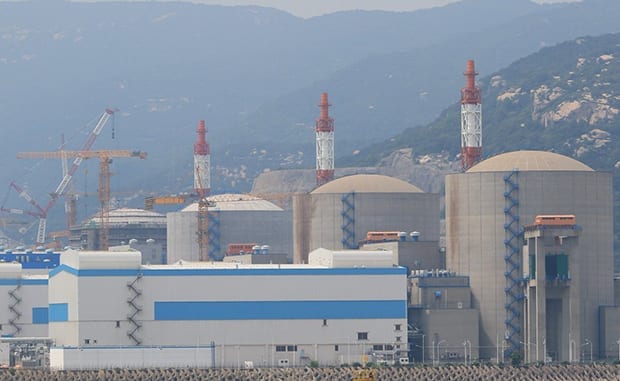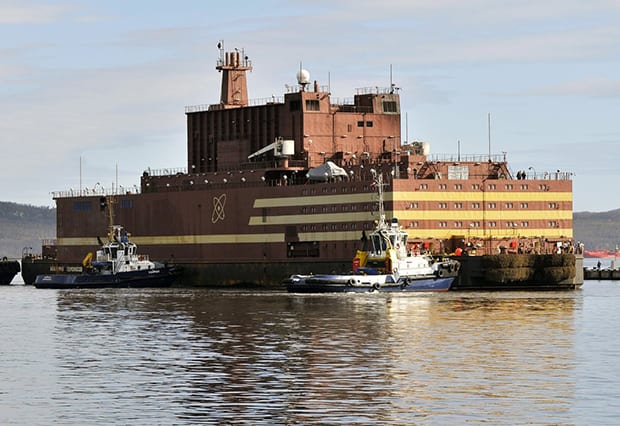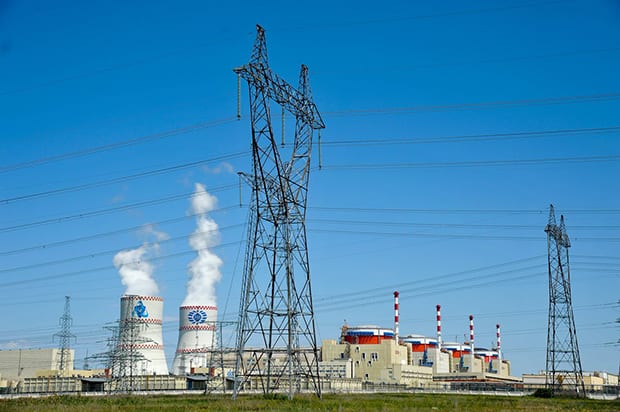A handful of nuclear power projects around the world completed notable achievements recently: Rostov 4 entered commercial operation, Tianwan 4 achieved first criticality, the Akademik Lomonosov floating nuclear power plant completed fuel loading, Leningrad II-1 received its commissioning permit, and the dome was installed on Karachi 3.
Rostov 4
Rostov Unit 4 was placed into commercial operation on September 28, three months ahead of schedule. The reactor is the last VVER-1000 type that will be constructed in Russia. However, Rosatom said the design incorporated some safety elements that are used in Generation 3+ power units.
“Rostov NPP [nuclear power plant] is the first NPP in the newest history where the so called straight-line construction that provides both adherence to deadlines and maximum effective use of materials and financial resources was revived. It is due to this type of construction [Rostov] NPP was constructed not only 3 months earlier, but with the high quality,” Director General of Rosenergoatom JSC Andrey Petrov said in a press release announcing the achievement.
Construction began on the first reactor at the Rostov site (Figure 1) on September 1, 1981, according to the International Atomic Energy Agency. However, Unit 1 did not enter commercial operation until Christmas Day 2001. Work on Unit 2 began May 1, 1983, but it fell even farther behind schedule, entering commercial operation in December 2010. Unit 3 took the least amount of time to construct—about six years from start of construction to commercial operation on September 17, 2015—while Unit 4 required more than eight years to complete.
“For all the employees of the Division Rostov NPP is a very important facility, as when constructing the second, third and fourth power units we, in fact, revived the construction sector of [the] nuclear power industry: we expanded the capacity, implemented new technologies, trained personnel,” Valeriy Limarenko, chief of the Engineering Division of Rosatom, said. “I congratulate all participants of this grand project with our big mutual achievement!”
Tianwan 4
Tianwan Unit 4 was brought to its minimum controllable power level on September 30, marking the final stage of first criticality procedures. The first criticality procedures were commenced on August 25 when the first fuel assembly was installed in the reactor. A total of 163 fuel assemblies were ultimately loaded. Rosatom said the work was performed in automatic mode.
“Loading of fuel was completed ahead of schedule, and after obtaining all the required permits, power unit No 4 of Tianwan NPP was brought to minimum controllable level of power. A controlled chain reaction started, the monitoring systems recorded the first neutrons. This will be followed by a power start-up and connection of the power unit to the energy grid of China,” Alexey Bannik, vice-president for projects in China of JSC ASE EC, said in a press release.
Tianwan NPP (Figure 2) is the largest facility being built within a Russian-Chinese framework of economic cooperation. Like the Rostov plant, Tianwan’s design is based on the VVER-1000 reactor type. Units 1 and 2 entered commercial operation in 2007. Rosatom handed over Unit 3 to Jiangsu Nuclear Power Corp. in March of this year. Unit 4 is expected to enter commercial operation in 2019.
 |
2. Russian-Chinese nuclear cooperation. The Tianwan nuclear power plant is the largest facility being built within a framework of cooperation between Russia and China. Courtesy: Rosatom |
Akademik Lomonosov
Fuel loading was completed on the second of two reactors for the Akademik Lomonosov floating NPP. The portside reactor plant is touted by Rosatom as the world’s only floating nuclear power plant, although there are obviously many naval ships and submarines with nuclear reactors.
“We plan to complete all final process operations at the facility before the end of this year. By now, specialists have completed one of the major tasks, [that is], the loading of nuclear fuel in reactors No. 1 and No. 2 of the plant. The next key stage will be their first criticality in October–November this year after the corresponding permit is received from Rostechnadzor. Then, the integrated birth trials will follow, which are necessary before the reactor is brought to design capacity,” Vitaly Trutnev, head of the directorate for building and operation of the floating nuclear co-generation power plant, said in a press release.
Next year, Akademik Lomonosov (Figure 3) will be towed to the Arctic seaport city of Pevek, the northernmost town in all of Asia. Currently, coastal infrastructure, hydraulic structures, and on-shore site construction is in progress to accommodate the facility. The floating plant will replace power from the Bilibino NPP and Chaunskaya cogeneration plant, which are being phased out.
 |
3. First-of-its-kind plant. Akademik Lomonosov is a dual-unit floating nuclear power plant that will be connected to the power grid in the seaport city of Pevek. Courtesy: Rosatom |
Leningrad II-1
Russian regulator Rostechnadzor has issued the commissioning permit for Unit 1 of Phase II at the Leningrad NPP in northwest Russia. Rosatom announced on September 20 that the permit confirms the unit is ready for operation.
About a month earlier, Rosatom said the final commissioning test, which involved operating the VVER-1200 reactor at nominal power for 15 days, had been completed.
“The successful completion of the commissioning tests confirmed the technical readiness for commercial operation of the unit 1 reactor,” said Vladimir Pereguda, director of the Leningrad plant. “The results of the final comprehensive test showed stable operation of all the main and auxiliary equipment, the reactor safety systems and its full readiness for power generation in accordance with the project.” He added, “We accomplished this task two months ahead of schedule and consider the milestone a great achievement for the team.”
Karachi 3
The dome for Karachi Unit 3 in Pakistan was lifted into place on September 29, marking a significant milestone in the construction of the Chinese-developed Hualong One unit. The dome measures 46.8 meters in diameter and weighs about 388 metric tons. The unit’s nuclear island was completed earlier this year, and the reactor and steam generators were pre-positioned in September. Focus will now shift to equipment installation.
Pakistan currently has five operational reactors. Karachi Unit 1 was connected to the grid in 1971. Construction began on Units 2 and 3 in 2015 and 2016, respectively. The Chashma NPP is home to the other four operational units, which all entered service in the 2000s.
—Aaron Larson is POWER’s executive editor (@AaronL_Power, @POWERmagazine).
The post Nuclear Power Roundup: New Milestones Reached on Several Reactors appeared first on POWER Magazine.
